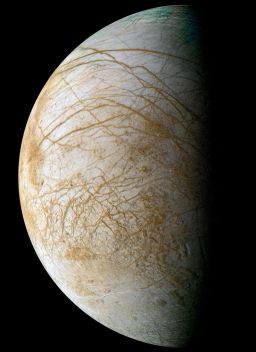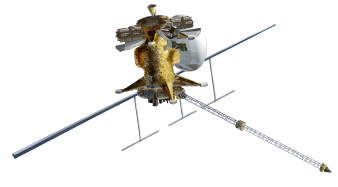Emily Lakdawalla • Apr 14, 2009
Ted Stryk: Europa Jupiter System Mission Colloquium
Ted Stryk sent me the following notes on a meeting on the Europa Jupiter System Mission held on April 9 and 10. Thanks, Ted! --ESL
On April 9, the University of Tennessee's Earth and Planetary Sciences department hosted a colloquium led by Bob Pappalardo of JPL to discuss the recently selected Europa Jupiter System Mission (EJSM). Pappalardo began by discussing our current, post-Galileo understanding of Europa. It is thought that the current ice shell is 60-100 million years old. Due to a small amount of torque applied to the Jupiter-facing side at its closest point in its orbit [caused by tidal forces from Jupiter], the outer shell rotates at a slightly asynchronous rate (a ballpark number given was one extra rotation for every 10^6 orbits). This conclusion is based on observations of the positions and orientations of linear features on Europa; the stresses on the ice crust that made those linear features seem consistent with Europa having picked up about a third of a rotation since the ice shell formed.

NASA / JPL / Ted Stryk
Highest-resolution global view of Europa
Galileo captured this view of Europa on its 14th orbit of Jupiter, on March 29, 1998. The image is a mosaic of five different pointings. The filters used for this image cover a broader range of the spectrum than human eyes can see. Galileo was 143,000 kilometers from Europa when it took this image, at a phase angle of 77°. Image scale is 1.5 kilometers per pixel. The area shown is primarily the anti-jovian, trailing hemisphere.The radar on the proposed Europa orbiter should be able to penetrate the hard, brittle surface layers of ice and map out the layer of ice below. Unfortunately, these softer regions are more opaque to radar than are the brittle outer regions, so it may not be able to see down into the actual ocean. However, if some of the "thin ice" models that some scientists favor prove correct, and the ice shell is only 2-3 km thick, then the radar system should see right through it. So, in other words, it should settle the thick ice vs. thin ice debate once and for all. However, some of the thick ice models allow for some small thin patches in the ice shell, which means that even with a thick shell we might have some "windows" through which to look directly into the ocean. Pappalardo stressed that if they had to cut the payload to just one instrument (not that this is being considered -- he was trying to make a point), it would be the radar.
The imaging system is also impressive. It will obtain global multispectral coverage in stereo at 100 meters per pixel. It will have a high resolution camera with a resolution from orbit of 10 meters per pixel, plus a strip down the center at 1 meter per pixel. The plan is to design a system that could function as a framing camera during the early part of the mission, during which it is conducting flybys of Jupiter's moons. However, in orbit it will act as a linear array, using orbital motion to scan the surface of Europa. [For context, Cassini and Galileo were both designed with framing cameras because all their moon encounters were flybys, which image geometry changing rapidly. Examples of linear array cameras include Mars Orbiter Camera on Mars Global Surveyor and HiRISE on Mars Reconnaissance Orbiter -- it's a much better choice for an orbiting mission. --ESL]
Given that the audience included a number of geologists, some interesting questions came up. First of all, several people noted that the features attributed to pulling apart due to tension don't have corresponding compression features elsewhere on the moon. Pappalardo acknowledged that this is an ongoing problem, although our global coverage of Europa isn't good enough to be sure that the compression features don't exist. Another issue that geologists noted was that some of the magnetometer observations attributed to an induced magnetic field via the global ocean may actually be due to piezoelectric forces (electricity generated when mechanical force is applied) from tidal strains on the rocky interior.
All in all, it was a very interesting and informative presentation. Pappalardo was headed to Vienna, Austria, to go to a meeting on planetary protection requirements for the mission. It will be interesting to see how planning unfolds in the coming months, as the process by which people can propose instruments will be starting this summer.
Support our core enterprises
Your support powers our mission to explore worlds, find life, and defend Earth. You make all the difference when you make a gift. Give today!
Donate

 Explore Worlds
Explore Worlds Find Life
Find Life Defend Earth
Defend Earth


